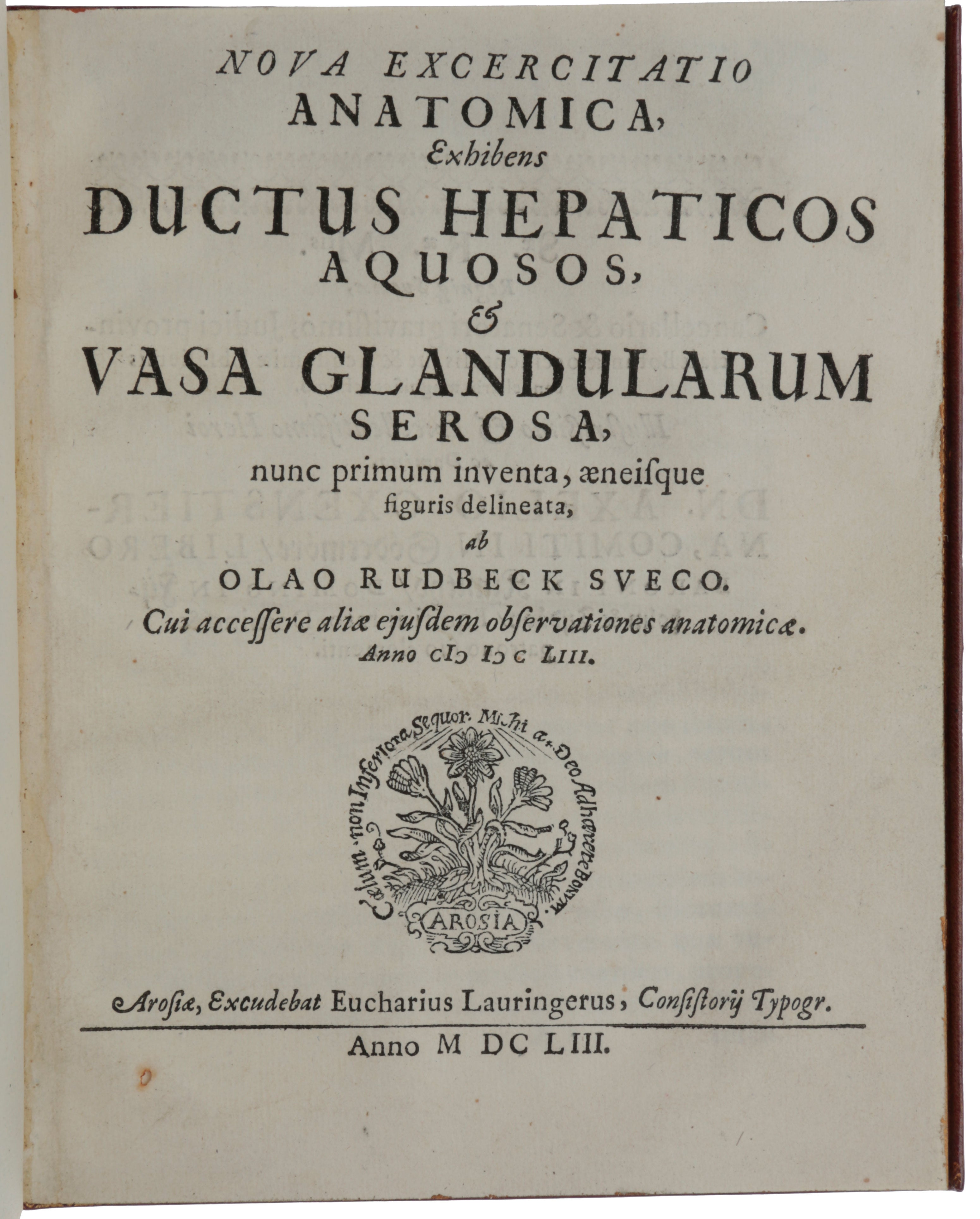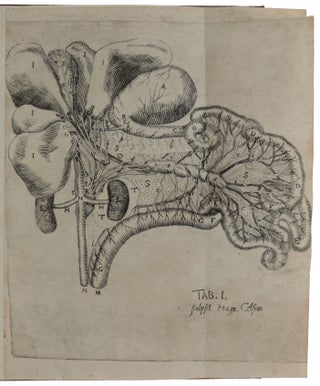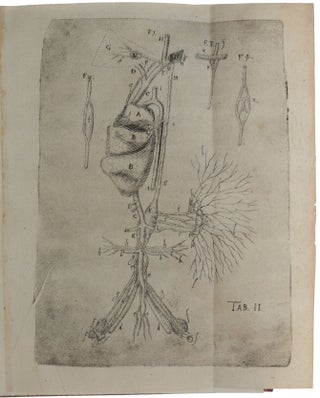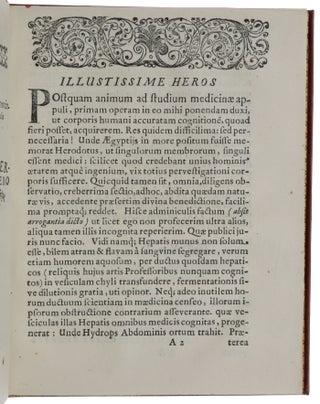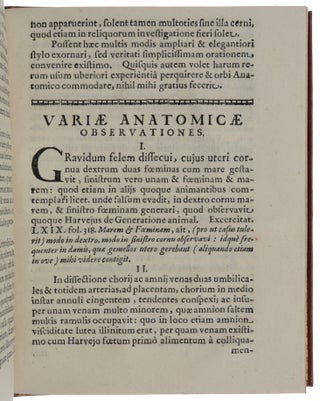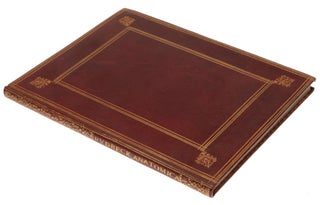Nova exercitatio anatomica, exhibens ductus hepaticos aquosos, & vasa glandularum serosa, nunc primum inventa, æneisque figuris delineata.
Arosia [Västerås]: Eucharius Lauringer, 1653. First edition of “one of the great medical rarities” (Norman), documenting the discovery of the lymphatic system; this is possibly the only copy in private hands. “Inspired by Harvey’s De motu cordis, anatomists in the second half of the seventeenth century were drawn to the study of vessel systems in animals. One of these was Olof Rudbeck, who, in 1650, at the age of 20, discovered the lymphatic vessels, along with the thoracic duct, which had been independently discovered by Pecquet. After a year spent on dissection and vivisection (he later stated that he had used nearly 400 animals in his investigations), Rudbeck made the distinction between the lacteal system, which carries chyle from the thoracic duct, and the lymphatic system, which contains a clear watery fluid. He demonstrated his discoveries in 1652 before Queen Christina and her court, but put off publishing them until the following year, when he issued the present work describing the structure and course of the lymphatic vessels and their valves, the lymph glands, and the nature of the lymphatic fluid. The youthful Rudbeck’s delay embroiled him in a priority controversy with the powerful Thomas Bartholin, who had been researching the lymphatic system at about the same time, and whose Vasa lymphatica had appeared just a few weeks before Rudbeck’s pamphlet. Rudbeck’s priority over Bartholin is now generally supported, and his description considered more complete” (Norman). Although the controversy caused much ink to flow between Rudbeck and Bartholin’s supporters, it is ultimately of less interest than the common context of these parallel researches: “Whether Pecquet or Rudbeck first identified the thoracic duct, or whether Bartholin or Rudbeck first described the lymphatic system, is finally less important than the testimony these disputes over priority give to the broader consensus across Europe as to the nature and direction of anatomical and physiological research after Harvey” (Grolier Medicine). We have located only the National Library of Medicine copy in the US. The present copy is apparently the only one to have appeared at auction: first in 1985 (Sotheby’s, 7 November, lot 678, £8,800), purchased by Quaritch; then at the Haskell F. Norman sale in 1998 (Christie’s, 16 June, lot 760, $57,500); and finally in 2013 (Christie’s Paris, 6 November, lot 56, €35,000). The book acquired its present binding between the last two sales. Rudbeck (1630-1702) was the son of Johannes Rudbeckius, bishop of Västerås, and the most important Swedish ecclesiastic of his time. He received his early schooling in Västerås, then, in 1648, entered the University of Uppsala to study medicine, where he learned the fundamentals of anatomy and botany from Johannes Franckenius. Rudbeck then began to work on his own, particularly in animal anatomy. In 1650, “Rudbeck watched the preparation of a newly-slaughtered calf. When the heart was removed, Olof saw white liquid dripping from the superior vena cava, and when he searched for the origin of this fluid, he discovered the thoracic duct. He dissected this duct retrograde until he observed a slight dilatation that he termed ‘saccus lacteus’ or ‘vesicula chyli’. Rudbeck made this discovery independently of the work of Pecquet, Mentel and Vesling. During the ensuing two years, Rudbeck continued vivisections and defined the continuation of the lacteals, vesicular chyli, and the thoracic duct terminating in the central veins of the neck. He performed more than 400 animal dissections including cats, dogs, calves, sheep, goats and wolves. He termed these vessels ‘vasa serosa’ and ‘ductus serosi’ because they carried not only chyle but also straw-colored liquid. He emulated the physiologic techniques of Harvey using strategically placed ligatures and came to understand that the lymphatic network is a system of closed vessels similar to the arteries and veins. Later he found lymphatics of the liver and their retrograde connection with the vesicular chyli and lymphatic drainage of the colon, rectum and esophagus, the lymphatics of the spermatic cord, lungs, abdominal wall and around the crural vein and later within the chest. He clarified the existence of lymphatics throughout the body, their connections with lymph glands and their termination in central (thoracic) ducts and finally in the jugular subclavian veins of the neck. With the ligature technique, Rudbeck unequivocally substantiated that lymph flowed along the portal vein but away from the liver, and probably was the first to refute the blood-forming role of the liver, against the established dogma of the ‘divine’ Galen. “In April 1652, Queen Christina of Sweden, the ‘illustrious virgin of Europe’, stopped in Uppsala, and [Nils] Stensen asked Olof Rudbeck to demonstrate before the royal court the lymphatics of a dog. Among those present were the Queen’s physicians Bromsius, Palmeron, Wullen, and many important personalities from the University of Uppsala. Likely also present was Thomas Bartholin. On this occasion, Bromsius informed Rudbeck of the work of Pecquet who had lectured in Stockholm a little earlier. Later Bromsius provided Rudbeck with a copy of Pecquet’s book [Experimenta nova anatomica, Paris, 1651]. “One month after this demonstration, Rudbeck submitted his medical thesis ‘De circulatione sanguinis.’ He was then only 22 years old, but he dared to write in opposition to Galen’s teaching. Approximately 14 months later, Rudbeck published his discoveries concerning the ‘vasa serosa’ in a 48-page book entitled ‘Nova exercitatio anatomica, exhibens ductus hepaticos aquosos, & vasa glandularum serosa, nunc primum inventa, æneisque figuris delineate,’ or ‘New anatomical investigations demonstrating the aqueous efferent ducts of the liver and the serous vessels of the gland, now for the first time discovered and described with illustrations.’ “In a ‘dedicatory Epistle’ he explained that ‘the glands of the body draw out from the blood a serous liquid like a residue; by what means this is done, however, and [by] what channels they then rid themselves of the fluid, was obscure: fortune has revealed this to me. For glands situated near the crural veins, the sides of the heart, the esophagus, and the mammary veins, carry a watery liquid to the chylous ducts by virtue of certain vessels.’ “In the first chapter, he explained using the physiologic technique of Harvey, ‘when I placed a ligature around the portal vein and the bile duct, sometimes ducts (lymphatic) became visible, distinctly engorged between the liver and the ligature, but collapsed below the latter.’ In the second chapter, Rudbeck noted the existence of ‘numerous valves which open in an outward direction.’ In chapter nine, he raised ‘the significance of this discovery for medical practice,’ in discussing the etiology of edema and ascites. He wrote, ‘I think it not unlikely that pathological changes in these vessels may give rise to disease and particularly to ascites if they become obstructed by viscid, thick or mucoid fluid. Their occlusion causes swelling of the glands … The swelling increases daily as long as the vessels can stand the pressure.’ And later ‘… any glands which have these vessels may cause a watery dropsy.’ “After this work was published, Rudbeck travelled in Europe, and it was in a shop in Hamburg, Germany (1653) that he came across the book of the Danish anatomist Thomas Bartholin (1616-80) entitled ‘Vasa lymphatica, nuper Hanfniae in animantibus inventa, et haepatis exsequiae.’ Rudbeck, known for having a bad temper, immediately considered Bartholin’s work as plagiarism, and an atmosphere of violent animosity rapidly developed between the two men … “Around 1652 or 1653, as Rudbeck had previously demonstrated, Bartholin came to realize that periportal lymph in contrast to portal blood carries fluid away from the liver, and he probably understood that the ‘aqueous vessels’ were part of the same system as the lacteals. Bartholin designated these vessels ‘vasa lymphatica’ and the fluid that they carried ‘lympha’ which means limpid, clear, or transparent. He tried to confirm his discoveries in humans but only after dissecting eight cadavers (1654) did Bartholin finally visualize lymphatics in man. “Bartholin hurried to publish his results in May 1653. He first put the date of February 28 in his publication but in the next edition added ‘anno 1652.’ As soon as Rudbeck saw Bartholin’s book, Rudbeck maintained that the publication year was 1653 (the same date of publication as his book) and not 1652 as Bartholin claimed in the second edition. Bartholin did not reply personally to the dispute but rather sent his student Bogdanus to defend him. This confrontation between Rudbeck and Bartholin lasted until at least 1661. “Historical events led to popularization of the word ‘lympha’ from Bartholin probably because he was an important figure who frequented the royal court. Moreover, his discoveries had a large following and his students, namely Bogdanus and Moinichen, travelled widely in Europe demonstrating his ‘vasa lymphatica.’ Whether Bartholin carried out his experiments in 1652 or 1653, it seems that priority of the discovery of the lymphatic circulation should be attributed to Rudbeck because, at the time, presentation before the Queen of Sweden and physicians of the court was equivalent to official recognition and, in that sense, formal publication. “Rudbeck returned to Uppsala in 1654. In 1661, at the age of 31 years, he became Rector of the University of Uppsala and remained a leading authority for many years. His interests moved into botany and with the help of his children and students he illustrated more than 6000 accurate botanical drawings, some of which were published in the first volumes of his never completed ‘Campus Elysii.’ Rudbeck had wide interests and activities. He expanded the University, enlarged the library, erected buildings, and elaborated a water system. Known as the leading engineer in his country, Rudbeck even built by himself 50 compasses for the Swedish navy during a time of war. “Near the end of his life, Rudbeck’s attention was drawn towards possible mythological origins of Sweden as ‘the Atlanticus.’ In three enormous volumes, the first of 891 pages, he tried to demonstrate that the origin of Sweden itself was directly related to the Greek story of Atlantis” (Chikly, pp. 188-192). Garrison-Morton 1098; Bibliotheca Rudbeckiana 664; DSB, XI, 586-88; Facsimile edition (Uppsala, 1930); Norman 1855; Hagelin, Rare and Important Books in the Library of the Karolinska Institute, pp. 90-93; Jeremy Norman Catalogue 17, preface and item 448; Waller 8283. Chikly, ‘Who discovered the lymphatic system?’ Lymphology 30 (1997), pp. 186-193.
4to (179 x 140 mm), pp. [48], with errata on verso of last leaf and with two plates by Rudbeck engraved by Magnus Celsius numbered Tab. I and Tab. II (Tab. 1 very slightly cropped at fore-edge and with portion of upper margin torn away). Modern red morocco gilt, bookplate of Haskell F. Norman loosely inserted.
Item #5101
Price: $75,000.00

